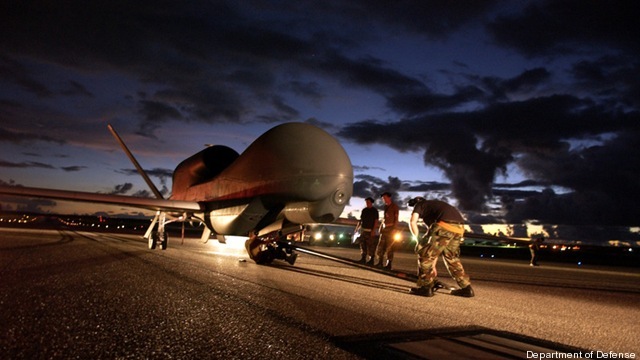 UPDATED TO INCLUDE MARKUP STATEMENTS JUNE 23; BACON AMENDMENT
UPDATED TO INCLUDE MARKUP STATEMENTS JUNE 23; BACON AMENDMENT
WASHINGTON: The HASC tactical air and land forces subcommittee is questioning the Air Force’s plans to shift 2021 funding to the high-priority Advanced Battle Management System (ABMS) from legacy ISR systems. The HASC body has gone so far as to hold the ABMS budget as collateral against retirement of the RQ-4 Global Hawk.
UPDATE BEGINS. “This mark pays particular attention to the department’s development, sustainment, and management of manned and unmanned intelligence, surveillance reconnaissance aircraft and supporting systems,” Rep. Donald Norcross, subcommittee chair, said in his opening statement at the June 23 hearing. “Of increasing concern is how the service plans appear to increase risk for Combatant Commanders, and their requirement for these systems — I have heard from so many of you on this issue.”
In its markup of the 2021 National Defense Authorization Act released yesterday, the subcommittee expressed broad skepticism about the ABMS program, which is being designed as the service’s technological pillar upholding DoD’s high-priority Joint All Domain Command and Control (JADC2) concept. The subcommittee’s concerns echo those recently aired by the Government Accountability Office (GAO) in its review of the program, including on costs and actual requirements for the technologies being planned. UPDATE ENDS.
The subcommittee language would block 50 percent of planned spending on ABMS if DoD fails to certify that the planned replacement for Global Hawk would cost less both to operate and sustain, as well as provide equal/better capability to Combatant Command commanders.
Besides demanding quarterly briefings on each ABMS “On-Ramp” exercise, the subcommittee also wants Air Force Secretary Barbara Barrett to provide a detailed report on the “capabilities, technologies needed to implement and achieve these capabilities, and a timeline for technology maturation and notional fielding schedule across the future years defense program (FYDP),” according to the draft text. As Breaking D readers know, the next ABMS On-Ramp is planned for Aug. 31-Sept. 4, and will focus on bringing in commercial providers of artificial intelligence and data analytics capabilities, in a scenario focused on Space Command operations.
The committee further “expects this report to outline how ABMS intends to transition demonstrated capabilities into sustainable Programs of Record.” It also requires DoD’s internal watchdog Cost Assessment and Program Evaluation (CAPE) office “to conduct an independent cost estimate of any ABMS cost estimate prepared by the Air Force.”
The subcommittee mark also requires certifications before the Air Force can retire the EQ-4 drone-based Battlefield Airborne Communications Node (BACN), which the service intends to replace with the ABMS gatewayONE. GatewayONE, as Breaking D readers know, was demonstrated in the first ABMS exercise in December and allows legacy radios (such as those in the F-22 and F-35 fighter jets) to talk to each other.
While not linked to ABMS funding, the subcommittee also put its foot down on prohibiting the retirement of the RC-135 fleet, and demands that the Air Force provide a long-term modernization plan for its entire fleet (manned and unmanned) of intelligence, surveillance and reconnaissance aircraft.
UPDATE BEGINS. The markup also taps the Army to provide information on its long-term plans for ISR platforms — among a series of reporting requirements for Army modernization programs, including the Future Vertical Lift (FVL) program’s sensor development efforts.
A committee staff member told the hearing that while the provisions were designed to “tackle similar issues,” the committee “has a lot of questions surrounding the Air Force programs and wanted to drive home the point that we need to see a comprehensive plan for them.” UPDATE ENDS.
Funding restrictions also are put into place until DoD can explain how the Next Generation Air Dominance (NGAD) activities by the Navy and Air Force intersect, and are not duplicative. The Air Force’s NGAD approach is looking at a mix of sixth-generation fighters to replace the F-35 and autonomous drones. The Navy, on the other hand, is looking at a replacement for its F-18 Super Hornets under its NGAD effort, a program that previously was called the F/A-XX.
The draft NDAA would “limit the Secretary of the Air Force and the Secretary of the Navy from obligating more than 85 percent of funding authorized to be appropriated for fiscal year 2021 for the Next Generation Air Dominance capabilities” until the CAPE director “performs a non-advocate review and submits a report to the congressional defense committees that assesses the separate efforts of the U.S. Air Force and the U.S. Navy regarding the Next Generation Air Dominance portfolio of capabilities being developed by each Secretary.”
The subcommittee further threw a slew of reporting requirements at DoD and the various services. These include “new reporting requirements” on F-35 “software testing methodologies, mitigation of physiological episode occurrences, and pertinent issues approaching the full-rate production decision in early 2021,” according to the subcommittee’s summary.
“Regarding the F-35 Joint Strike Fighter program, the mark, through appropriate levels of oversight, builds off previous committee action and works to ensure the F-35 will have a successful full-rate production decision, as well as a fully reliable and affordable plane for the future,” Rep. Vickey Hartzler, ranking subcommittee member, told today’s hearing.
UPDATE BEGINS. Rep. Don Bacon chimed in to say that he will submit an amendment to the full House Armed Services Committee that will ask the Air Force to explain, in an unclassified manner, how much of its funding pot for intelligence-related programs actually is pass-through money — that is, funding for other agencies, including the National Reconnaissance Office.
“We know about 25 percent of the Air Force’s top line goes to intelligence, other organizations, outside of the Air Force. And I just think it’s good to have more transparency on where your money’s going,” he said. UPDATE ENDS.
Navy jet trainer fleet operations remain paused after engine mishap
One week after the incident, a Navy spokesperson says the service is continuing to assess the fleet’s ability to safely resume flight.


























